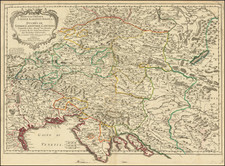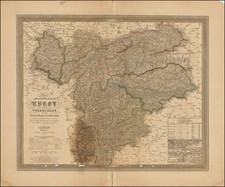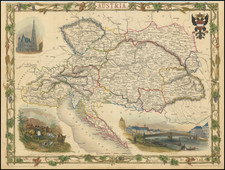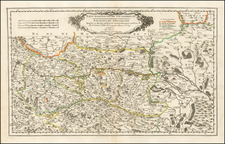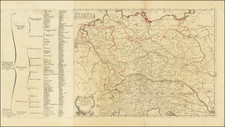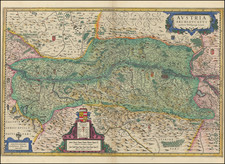Fine original antique map of Saltzburg.
This 1644 bird's-eye view of Salzburg, Austria, by Merian offers a detailed southern-oriented perspective of the city, highlighting its historical architecture and urban landscape. Centered around the Salzach River, the view prominently features the cover bridge, a precursor to the modern Staatsbrücke, which has historically linked the two parts of Salzburg's Altstadt, the entirety of the walled city at that time.
The map is annotated with letters identifying 24 major structures, including monasteries, fortifications, churches, and palaces, all connected to a key for easy reference. Among these, the Cathedral, or Thum Kirch, stands out as a notable landmark. The eastern bank of the Salzach is dominated by the forested Kapuzinerberg hill, now a significant green space within the city. Although the fortress walls of the old city's northern part are no longer visible, having been replaced by modern developments like Franz-Josef Strasse, the gardens of Schloss Mirabell and the University Mozarteum are still identifiable in this historical representation.
This engraving not only captures the architectural essence of 17th-century Salzburg but also serves as a valuable historical document, tracing the evolution of the city's urban landscape over centuries.
Mathaus Merian (1593-1650) was the father of engraver Matthäus the Younger, and of the painter, engraver, and naturalist Maria Sibylla Merian. He was born in Basel, Switzerland and trained in engraving in Zurich. After a time in Nancy, Paris and Strasbourg, he settled in Frankfurt. While there, he worked for Johann Theodor de Bry, the publisher and son of the travel writer. In 1617, he married Maria Magdalena de Bry, Johann Theodor’s daughter. In 1623, Merian took over the de Bry publishing house upon the death of his father-in-law. Merian’s best known works are detailed town views which, due to their accuracy and artistry, form a valuable record of European urban life in the first half of the sixteenth century









